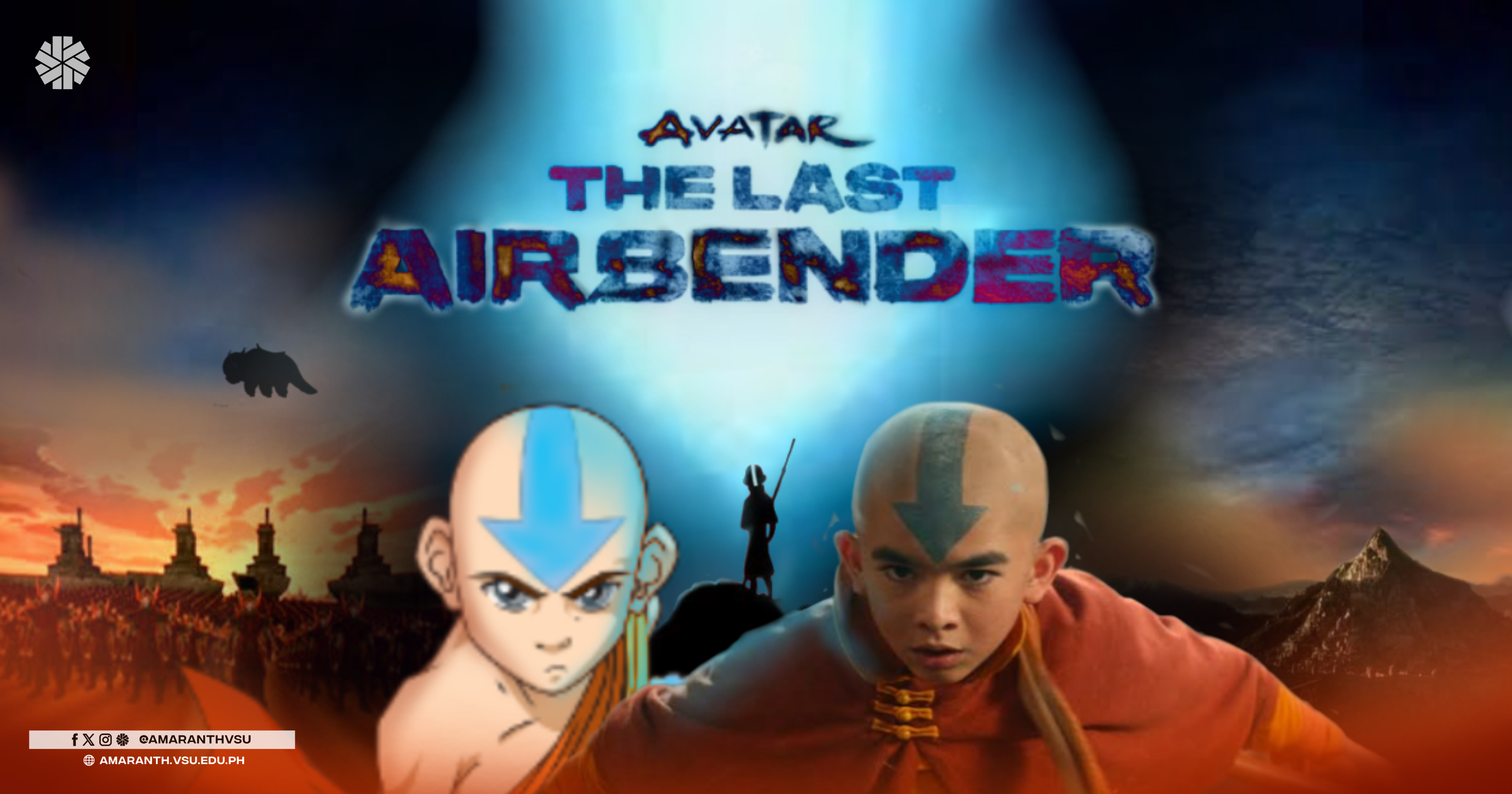Imagine being born as the only person in the world who can master all the elements among four nations. Instead of playing with your friends and enjoying life as a kid, the burden of being the “chosen one” is suddenly thrown at you. The weight of the world is in your hands, it feels like your childhood is being stolen, and people are expecting you to be there for everyone. What will you do?
"Water, Earth, Fire, Air. Long ago, the four nations lived together in harmony. Then everything changed when the Fire Nation attacked." Are you familiar with this iconic intro? If you are, then glad to have you back, co-bender! If not yet, then welcome to the Avatar: The Last Airbender (ATLA) universe. In an era of democracy, will a kid’s journey to saving the world still prevail and be relevant in teaching values of empathy and kindness? Hold on to your cabbages, ‘cause the Avatar is back! And as a superfan of the series, here is everything that geeks me out about it.
This is the story of Aang, a young airbender who feared his responsibility of becoming the Avatar, the only person in the world who can bend all four elements; air, water, earth, and fire. He was told that his destiny is to end a war that started long ago — a war against an oppressive nation conquering the others, using force to colonize the entire world. He ran away when his obligation hit him hard at the age of 12. He got frozen somewhere in the waters and woke up a hundred years later. Moments after waking up, he then learns that his family, the entire Air Nomads, had already gone extinct due to the genocide caused by the Fire Nation during his disappearance. Despite his longing for his family, he must face his destiny. Together with his newfound friends, they must wander the world and master all four elements for him to face the ruthless Fire Lord.
So, what is so special about the Avatar’s story?
A symbol of hope.
The Avatar is a physical manifestation of hope and courage. In his world, people had lost hope when he disappeared and the war had never ended in a hundred years. Upon his return, people started to remember how it is to fight for what they think is right, to fight for their loved ones, and for their nation. Aang, Katara, Sokka, Zuko, and Toph are merely just kids. I was always fascinated by how these kids managed to take down not just a village or a city, but an entire nation. And, it is not just their skills or special abilities that made them win the war, but their creative and playful minds paired with their drive to change a system. A system of government that attempts to rule their world, a system where terror is used to manipulate and oppress the weak, attain more power and use them for personal gain. If you ever choose to watch the animated series, especially when the main characters fight alongside the White Lotus to liberate Ba Sing Se from the Fire Nation, you will realize that some people are just waiting for the right time, and the right people, to have the courage to fight. Even the old ones are just waiting for the youth to make a move, the hope for them to make things right.
Staying true to who you are
Aang was raised by the monks. While he was training, he’s been taught principles and virtues that helped him become the young Avatar that he is. When the time came that his role in the world had been tested, such as the need to kill to save more lives or choosing between his life or the others, the voices of his mentors would echo in his mind, saying to ‘never lose who you are’. So Aang chooses not to be influenced by principles that he does not believe, even if it’s from the previous Avatars. He chooses not to kill because killing is not what he does. He knows that a world without him as the Avatar will be better than the Avatar without a world, so he finally accepts his role and uses the most of his abilities to save the people he loves, and the world, even if it costs his life. Most importantly, while becoming an Avatar, he never forgot who he really is and what he really wants – a playful kid who just wants to see people smile, without fear, and full of aspirations. No matter what circumstance is faced, it is vital to remember who we are and where we came from. Because this will guide us to who we want to be and what we want to do in the world.
Seeing people as people, not GOOD or EVIL.
As cliche as it is, there is more to what we see on the cover. Each person has a backstory, and it shaped them into who they have become. Zuko, the banished prince, has been the highlight of the show for his undeniably satisfying character development. He started as a nemesis to the Avatar, with the goal of capturing and bringing him to his father, the Fire Lord, to regain his honor and be a deserving heir to the throne. Later in the story, with the guidance of his Uncle Iroh, he realizes that his circumstances lead him to be part of the Avatar’s team; to free the colonies from the fire nation, claim his right to the throne, and be the leader of change. Each character in this series has a background story that would make us understand where they are coming from. Even Aang himself sees the good in people, regardless if their means of doing stuff weren’t that justifiable. He still believes that people can change if only given the right options.
False idea of unity. ‘Tyranny? You mean unity?’.
A line from the Fire Lord himself. It's a pity how people can still get blinded to thinking that a nation or a world where one rules for the sake of their names could lead them to “unity”. That an oppressive, tyrant, and ruthless leader can offer peace and order. The Fire Lord Ozai is the main villain of Aang's story, but he is not just Aang’s nemesis, he is the world’s. He offers himself to be the ruler of the world as the Fire Nation expands their colony, conquering one nation at a time. Unity is not about when all serves under one rule, or when everyone agrees on everything. Does unity ever truly exist? Well, the Avatar’s journey is not about attaining unity, it is about restoring balance to the world. And, this series shows that true balance is not achieved through sacrificing others for the sake of the greater good, balance is achieved by adapting to changes while staying true to what is morally right.
War is not a game
As much as I want to focus on the light elements of the series, war is where the plot’s setting revolves. The fact that the live-adaption series on Netflix begins with the genocide of the Air Nomads means that the main focus of the story is not to bring comfort, but to make us realize the weight of a war. This is more than the adventures of Aang, it is about his quest to not make the bloody sacrifice of his people be put in vain. Throughout the series, fight scenes may amuse us but what they truly imply is that in wars, lives will be in danger, nations will be destroyed, and people will die. By winning a war, people don’t really truly win, they just get a sigh of certainty. But at what cost? Peace is only temporarily attained at the end of any war.
Friends are family
Aang lost his family but found a new one. I could not imagine if the story was just all centered around Aang, without the side characters that made his journey more rewarding and wholesome. His friends supported him in doing things that he once thought were impossible. ‘But imagine what will happen if you don't even try?’ Katara’s words to Aang mean a lot. A friend who is there trying to lift us up when we don’t feel okay about everything is a friend that we should keep. A friend who loves us like family is also a family that we must protect. And, we don’t have to find that friend, we can try to be ‘that’ friend.
A cup of tea
The spirit of the show would not be complete without the wise words of Uncle Iroh, a retired Fire Nation general who became Prince Zuko’s guardian. His worldview changed after the failure of his conquest to the Earth Kingdom of Ba Sing Se, and the death of his son. His comforting words change lives, they became the guiding values to the realizations of his nephew, Zuko, to the journey of the other characters, and even to Avatar Aang. His words also traverse beyond screens, touching the lives of the viewers. “Sometimes, the best way to solve your own problems is to help someone else.” He believes that a good story is best shared with a cup of tea. A good conversation is with someone who truly listens. We should also always remember that whenever everything turns noisy, it’s okay to take a break, grab some tea, listen to the sound of nature, and reflect within ourselves.
The Original Series
The original Avatar: The Last Airbender is my topmost undefeated favorite animated show. The main highlight of the show is its characters. The story arcs of each individual is just top-notch, the notable amount of growth that they get when each episode is compared is astounding. It is a wild ride of laughter, action, tear-bending, and amusement. Although animated, doesn't mean that the themes of the show are just for kids. It pulls fans from different demographic backgrounds; from young to old ones, from Western to Asian viewers, anime to cartoon fans, and more. The show has a number of young characters that made it light and fun for the viewers while delivering a cohesive and compelling narrative. While the story revolves around the kids’ adventures, it also has mature themes. It also talks about tyranny, cruel regimes of nation conquerors, oppression, emotional and moral dilemmas, community issues, depression, revenge, animal cruelty, and many more. Despite these deep topics, the show never failed to incorporate light-hearted scenes highlighting the importance of self-trust, true value of friendship, and love for family. Plus, the humor is just so uncanny and on point. Dull moments are just not in the ATLA animation’s vocabulary. There is a proper balance between funny moments and serious scenes, nothing felt forced into the storyline.
Netflix Adaptation
Now, Netflix attempts to bring everything we loved about the original animated series to life with hopes of never repeating the disappointment viewers had in the previous attempt, the 2010 The Last Airbender movie or what fans call "the movie that shall not be named" and "there's no live-action movie in the walls of Ba Sing Se". The producers of the new adaptation promised to give us a remix of the original, providing deeper storytelling while staying true to the spirit of the source material. This time, they got the representations right. Their world may be fictional but this might be the most Asian characters, played mostly by Asian actors, you’ll ever see in an American fantasy series. The fictional communities, the world-bending, and the bending styles are heavily inspired from Asian and Inuit cultures, traditions, and martial arts. I hate Pinoy-baiting, but I might as well mention that our boy, Aang, is played by a Filipino-American young actor, Gordon Cormier.
I have already seen all the episodes of the new adaptation, and it feels like a love letter to the original. They went for a more serious tone, which is effective for a Netflix series. It may not be perfect, but it caught the core motif of the animated show. The first few episodes felt rushed and some scenes were combined, that felt a little bit off. But as the episodes progressed, the characters grew on me, before I knew it, I was already glued to the screen and I finished all of It already. Although there were a bit of changes, which I think were necessary for the new producers to still have their own spin on the story, I can still say that the new live-action series remained faithful to the original. Also, get ready to tearbend because this show will pierce your soul. I understood the weight of the characters’ dilemmas, remembered and got a deeper understanding of the source material upon watching this new adaptation. There were few plot holes, cringe-worthy scenes, underwhelming lines, which is more noticeable for me who is so familiar with the original, but I can brush it off for the sake of absorbing the adaptation’s own flavor. I think the costumes and wigs should also improve. With all my mind-bending capacity, I can say that the new adaptation may not be as perfect as the original animated show, but it provided a promising version of the story.
Should you watch this live-action series? Yes. This will be the best way for the world of Aang to get known to more audiences. I hope that Netflix greenlights the 2nd and 3rd seasons already, for the three books of the story to be completed in a live-action adaptation. The kid actors are also growing up very fast, they must start filming the seasons back-to-back. For those who are new to the story, Avatar: The Last Airbender is truly worth watching. The story gets deeper as you watch them again and again, and the plot thickens as you grow with the show and its characters.
As an Avatar superfan, I firmly believe that a masterpiece like this must be supported by whatever means possible. Just forget the old movie that should have not existed. Should you read its comic releases, see its original animated show, or watch the new live-action adaptation on Netflix, the Avatar’s legend will always bend its way into your heart.


